UFO
Thanks to Marcus Lindroos
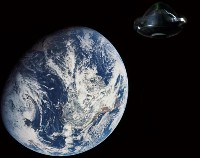
UFO approaching Earth. Like Space:1999 later on, UFO made extensive use of Apollo photographs. This Apollo 8 image of South America from an altitude of 30,000km was used for all long-range views of Earth. North is to the left. |
As explained in the pilot episode, the Supreme Headquarters Alien Defence Organisation (SHADO) was founded in 1970 by the U.S. following consultations with the British, French, German and Soviet governments, shortly after the first confirmed landing of an alien Unidentified Flyng Object on Earth. Later that year, a special secret committee of the United Nations attended by the representatives of six major nations, unanimously approved the plans for SHADO following USAF Commander Ed Straker's project presentation. The plan envisioned a new worldwide military-style organisation with personnel recruited internationally. The estimated time to become operational was 7-10 years. The list of required hardware included a fleet of "Skydiver" submarines that can launch hypersonic "Sky" fighter aircraft, a base on the Moon equipped with single-seat Interceptor fighter spacecraft, spy satellites and tank-like SHADO Mobiles on land. The American UN representative insisted that an American -- Col. Straker -- lead the new organisation since the USA is the biggest financial contributor. |
|
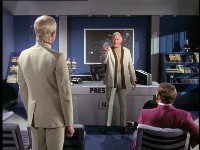
General Henderson (Grant Taylor), President of the International Astrophysical Commission. His chair (an "Elda 1005" designed by Joe Colombo) would later reappear in the Moonbase Alpha year 1 living quarters. |
Funding for SHADO is channelled through the International Astrophysical Commission (headed by Straker's former commanding officer, retired USAF Gen. Henderson), which seems to be an Intelsat-type organisation that also launches and operates its own unmanned and (by 1980-) manned "Space Tracker" space stations in cislunar space. However, SHADO still uses space more than any other organisation, performing as many manned spaceflights per month as IAC does in a year. Although an American heads SHADO, most of the personnel seen in the series seem to be British. The SHADO headquarters (hidden below Harlington-Straker Studios in Borehamwood - the outrageous "swinging 60s" SHADO uniforms are presumably part of the disguise!) and important SHADO bases and tracking stations are also located in England. This is possibly due to the fact Britain is the second-largest financial contributor and because the alien UFOs tend to target Britain/Ireland... |
|
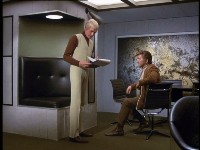
Edward Bishop (Comm. Ed Straker) and George Sewell (Col. Alec Freeman) were the principal actors of UFO. Here, Sewell is sitting on an Eames aluminium group management chair in Straker's office. The same type of chair would later be used in the Dragon's Domain Ultra probe ship. |
SHADO was set up in 1970-72 and construction of the SHADO moonbase (which houses a small fleet of Lunar Interceptor, Lunar Module and Moonmobile spacecraft) began in the mid-1970s in the eastern half of Mare Imbrium. The organisation became fully operational in 1980. The UFO kill success ratio over the first few years was good but by no means 100%. The main worry was the lack of backup in case of a massive UFO attack; consequently Straker requested twice as much funding from the IAC Council for an additional four new fully automated moonbases over the next ten years. However, SHADO was still operating only a single moonbase by the end of the series in 1984 so it seems the request was denied. It is possible "Moon City" (later renamed Moonbase Alpha) instead was set up as a large multipurpose facility for civilian as well as military users, including SHADO... The organisation probably was dissolved sometime before 1999 as the alien threat disappeared, but Moonbase Alpha still retain a number of military defence systems. |
|

SHADO Moonbase and Alpha. As one might expect, the earlier SHADO facility is much smaller than its successor which had grown to a "Moon City" of over 300 inhabitants by 1999. |
As in Space: 1999, there is a vigorous ongoing lunar exploration programme. The main lunar installation of the early 1980s seems to be SHADO Moonbase. It is located in the eastern half of Mare Imbrium near the Apennine mountain range (approximate location 6.5 deg. W; 21.5deg.N as shown on a map in the episode "Survival"). The SHADO Moonbase is officially known as a [NATO?] military installation that has "a complex and hazardous mission". Its true mission - defending mankind against hostile UFOs - is of course classified. According to international agreement, SHADO Moonbase is off-limits (incl. radio frequency), except in an emergency. The facility consists of five ~11-metre diameter spherical crew modules connected by walkways to a central section, which contains a "central park" as well as vehicle garages. Each module also has an emergency airlock to the lunar surface. It would seem that the base is equipped with Space: 1999 type artificial gravity generators. The main residence building is the "sleep sphere" while the moonbase command, communications and tracking facilities are supervised from the "control sphere". There is also a "leisure sphere" containing lounge and dining areas for the crew, including the SHADO Interceptor pilots, which are on constant standby in case of UFO attack. Other areas named in the series include "Area 7", "general quarters", "explosive store","reception/embarkation area" a gymnasium and a medical centre. The moonbase complex has an external air and water installation located a few hundred metres away on the lunar surface; it seems likely that all oxygen and water are extracted in-situ from lunar soil and/or recycled from waste. |
|
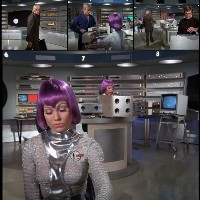
SHADO Moonbase Control Sphere Interior. The monitor trolley would be retained for Space:1999 as well. Note the female "space tracker" catsuits and mauve wigs! The small inserts show the other three corners of this room. The Moonbase Commander is seated in the middle with two Space Tracker consoles at opposite ends. |

Leisure Sphere interior. Capt. Steve Maddox (Drewe Henley, left) and Col. Freeman (George Sewell, right) are playing chess. Henley would later appear in The Bringers of Wonder. Other LS facilities: galley (upper left), chutes to Interceptors (centre), recreation centre audio+video (right). |
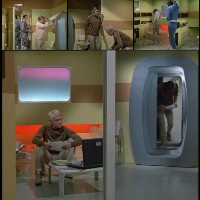
Sleep Sphere interior. Straker's bedside table (a Demetrio45 by Artemide) would appear in Space:1999 as well. The inserts show the other three walls of a standard 3-crew living unit. At left is a small wardrobe/crew hygiene station sealed off by a mirror. The crew sleeps on the inflatable beds at right. |
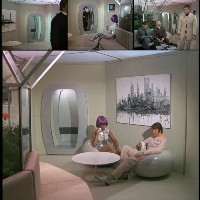
Central Park Interior. This octagonal room acts as a connecting node to the five spheres. The "Pastille" chairs (designed by Eero Aarnio) would also turn up as part of the alien spacecraft interior sets in The Infernal Machine and Mission of the Darians. |
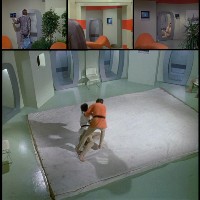
Gym and General Quarters Interior. To save money, the Central Park set was revamped as the Moonbase gymnasium in some episodes. This overhead view shows the general layout, with a pair of doors on the opposite wall plus single doors in the corners, next to video posts. In the "general quarters" version of this set, the corner doors lead to single bedrooms for visiting officers (left and right insert). There are no doors on the end walls at far left and right. |

The pressurised modules are connected to each other by long corridors, which also provide access to external airlocks on the lunar surface. Important lunar surface equipment include the SHADO Moonbase air/water complex (left), SHADO missile launcher tanks (centre) and the USSR "Sovatex" mobile rig (right) |

Vehicle Size Comparison. SHADO model images courtesy of Starship Modeller. 
Three Interceptors escorting a Venus Probe. The vehicles are stored in an underground hangar (bottom left). |
Apart from UFO tracking and detection, the SHADO lunar outpost also acts as a base for SHADO spacecraft. The main crew transfer and resupply craft is the Lunar Module - a 3-crew single-stage-to-orbit spaceship powered by a single large rocket engine. The Lunar Module is launched from high in the Earth's atmosphere by a large "Lunar Carrier" vertical-takeoff and landing (VTOL) jetplane to conserve rocket fuel. The Lunar Module is fast enough to reach the Moon in a single day, implying it carries "antigravity screens" like the Space: 1999 Eagles (an alternative explanation is the Lunar Module is completely refuelled at a space station in low Earth orbit before continuing its lunar journey). The Lunar Module lands vertically on the launch ramp of the SHADO Moonbase "Reception Sphere". The Moonbase complement is probably in the ~12-24 crew range so the crew rotation and resupply flight rate must be very high (a deleted scene from the "Flight Path" episode indicates there are flights at roughly 24 hour intervals). SHADO Moonbase houses three Interceptors; small VTOL one-man "space fighters" equipped with a single nuclear missile. The Interceptor crews are on constant standby for launch within two minutes of a UFO "Yellow Alert". The Interceptors mainly operate in cislunar space -- the craft does not have an atmospheric reentry capability -- but it occasionally performs missions in low Earth orbit as well (perhaps the Interceptor can be refuelled by other spacecraft to extend its range?). As in Space: 1999 the pilots rely extensively on computers for nuclear missile timing / guidance and course corrections (the data is supplied either by Moonbase or the Space Intruder Detector satellite). |
|

Moonmobile cockpit.The spacesuit helmets would later appear in Mission of the Darians. 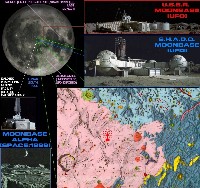
Important lunar locations in UFO and Space:1999. The vicinity of SHADO Moonbase is shown on a U.S. Geological Survey map in the episode "Survival". In the early 1980s there were several small civilian, military as well as commercial lunar outposts operated by different national and international organisations. By 1999, all lunar operations had apparently been consolidated through a single large international facility located near the lunar south pole -- Moonbase Alpha. |
Moonbase also has four VTOL suborbital transport vehicles ("Moonmobiles"). These can carry up to three astronauts and equipment to other locations on the lunar surface. The vehicle normally skims the lunar surface at an altitude of only a few metres (to avoid UFO detection?), but greatly resembles the Space: 1999 Eagle Transporter in other aspects. The design is closely based on the Moonmobile seen in the Captain Scarlet puppet series. The Moonmobile carries missiles for self-defence. Being a military installation, SHADO Moonbase itself is well armed. The Moonbase crew modules are equipped with rapid-fire cannons and there are also two missile launcher equipped tanks (these serve the same function as the "battle tanks" seen in the Space: 1999 episode The Infernal Machine). Unlike Space: 1999, none of the spacecraft is armed with lasers or other directed energy weapons (these presumably became operational only in the late-1980s or 1990s). Private companies such as the Dalotek Corporation also operate small man-tended mining facilities on the moon; these companies utilise the same spacesuits as SHADO so they are probably military suppliers trying to commercialise the new technologies. The USSR also maintains a manned lunar outpost located in the Apennines mountains some 150 miles east of SHADO Moonbase. The Soviet facility includes a large lunar surface rover operated by the state-owned Sovatex mining corporation (according to a newspaper headline in the pilot episode, "moongold" has been found in the Albategnius crater). Straker doubts the viability of commercial mining in one episode, since all the valuable deposits supposedly were taken away long ago. Beyond the Moon, it seems NASA has been launching a number of manned interplanetary "GSP"-class craft for a number of years. In one episode, the SHADO Interceptors escort a small and presumably unmanned probe returning from Venus (perhaps due to the "venusian plague" contamination hazard later alluded to in Space: 1999?). The International Astrophysical Commission carries out human space flight research using its fleet of "Space Tracker" stations (aka. "Deep Space Probes"). IAC is responsible for removing space junk and some Space Trackers occasionally (once a year) destroy hazardous space junk using explosive "limpet" probes. |
|
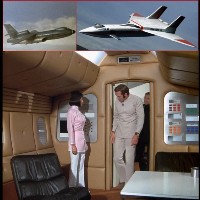
SHADO's airplane fleet includes a subsonic executive jet (left) and the Mach 4 Seagull X-Ray (right). The passenger cabin configurations are identical; this set was later used as part of the Ultra probe in Dragon's Domain. |
SHADO and its needs presumably acted as a huge technology driver in the 1970s. The aerospace industry had made considerable progress by the early 1980s, building on ambitious 1960s efforts such as Apollo, Concorde and US Air Force "X" projects. SHADO itself operates a fleet of supersonic transport aircraft as well as the submarine launched "Sky" hypersonic jet/rocket powered fighter capable of reaching a speed of Mach 5 and an altitude of up to 70 kilometres. It seems a military subcontractor (Ventura Aircraft Corp.) is trying to develop a commercial hypersonic civil transport aircraft as well. SHADO's most advanced flight computer is the "Space Intruder Detector" or S.I.D. - a massive unmanned space observation platform that normally is controlled by a large onboard computer. S.I.D. is capable of detecting UFOs and other spacecraft in deep space as well as on Earth; it can also calculate the trajectory of objects based on visual observation. The S.I.D. control computer has a speech recognition capability and normally communicates verbally with its users; it is very similar to the Space: 1999 Voyager and Moonbase Alpha main computers in this regard. |
|

Other UFO aerospace vehicles: SHADAIR Mobile Transporter (top left), SHADAIR Albatross rescue seaplane (centre left), SHADAIR Kingfisher helicopter (lower left), unmanned "Space Dumper" VTOL 2-stage rocket (lower right); Ventura Aircraft Corp. XV-104 experimental aircraft (top right). |
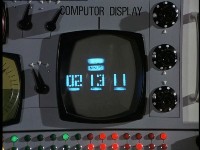
Lunar Module "Computor Display" (this countdown timer display also appeared in Collision Course). Onboard spacecraft computers play a major role in UFO. The SHADO Moonbase Interceptor space fighters rely on their onboard computers for most tasks, while the Lunar Module shuttles normally make computer-controlled landings. |
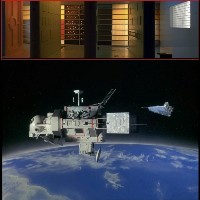
S.I.D. maintenance. Note spacewalking astronauts and "SID-2" mini-shuttle in the background. The S.I.D. interior (top) resembles the Space:1999 Year 1 "computer room". |
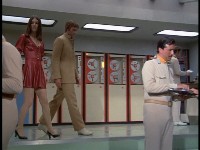
SHADO HQ Main Computer. Actress Susan Jameson (left) would later appear in Dragon's Domain while John Clifford (right) was originally Martin Landau's stand-in and made numerous appearances, including in The Dorcons. |
The computer technology featured in the series generally seems to be quite primitive (SHADO Headquarters uses mostly 1960s IBM equipment, possibly because it was set up as early as 1970-72). Some of the computer hardware was also reused on the Ultra probe (Dragon's Domain). Many computer applications would also appear in Space: 1999, e.g. computer "expert systems" (SHADO even runs "psychocomputer tests" to determine the risk of its employees becoming romantically involved with each other!). The SHADO HQ computer system tries to issue predictions based on e.g. previous UFO activity. There is also a global "International Crime Computer" system database, including voiceprints of criminals. Voiceprint and handwriting identification systems are in common use within SHADO. |
|

Straker's videophone (far right). It was originally developed for the Doppelganger movie. Actor Stuart Damon would later appear in the Space:1999 episodes Matter of Life and Death and The Bringers of Wonder. |
In the field of communications, many organisations (including SHADO Moonbase) are already using primitive desktop videophones - they would become even more important in Space: 1999. The technology may originally have been developed for security reasons (SHADO uses them to verify the identity of personnel contacting its facilities). Carphones and walkie-talkie like portable devices are also seen, but they are audio-only. |
|
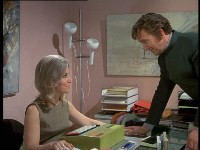
Straker's secretary Ms.Ealand (Norma Ronald) and Col.Alec Freeman (George Sewell). Ms. Ealand's computer keyboard would later appear as part of the Space:1999 Main Mission set. |
A keyboard bearing a striking resemblance to an early 1980s home computer also appeared in several episodes. It was mostly used as a typewriter by secretaries (without a cathode ray tube or line printer display, unfortunately!), and sometimes also as a command panel for opening/closing doors or audio communications lines. The same keyboard would later appear in several Space: 1999 episodes. There have been several breakthroughs in the field of medicine as well. Advanced drugs at SHADO's disposal include the X50 drug used by test pilots before being banned due to psychological burn-out problems (it speeds up heart,muscles,brain,coordination by a factor of up to 50) as well as an "infallible" truth serum. |
|
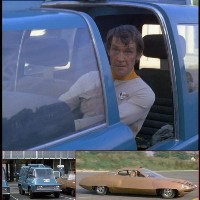
UFO featured a number of full-scale futuristic cars originally developed for Doppelganger. They include Straker's bronze coloured sports car (right) as well as blue jeeps. Actor Patrick Allen would later reappear as the ILFC chairman in the Space:1999 compilation movie Alien Attack. |
The early 1980s seem to be a period of rapid international integration, albeit within the West only (where racial prejudice "burned itself out" in the mid-1970s according to Straker). Cars in Britain now drive on the right hand side of the road, and the dollar is frequently used in the UK too. This is presumably an indirect result of the alien UFO threat, which results in nation states pooling their resources within the framework of existing political alliances. |
|

Royal Navy biochemical weapons crew. The radar screen can also be seen in the SHADO control room as well as in Dragon's Domain. |
However, there is no direct indication that the communist bloc nations (USSR, China) contribute to the effort, although it is mentioned in the pilot episode that the British government contacted Moscow before joining SHADO. A newspaper headline from 1980 mentions "border flare-ups" between Russia and China. Neither nation seems to be contributing personnel or hardware, and SHADO seems to be a Western "coalition of the willing" against UFOs (interestingly, the SHADO Moonbase galley does provide Russian and Chinese meals so perhaps the original intention was to have a truly global organisation?). In another episode, it is revealed that Britain's European allies developed very dangerous chemical weapons of mass destruction in the 1970s, suggesting the Cold War was still going on at that point in time. |
|
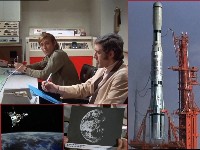
NASA launches the B142 space probe. The NASA main mission operative at left (Bob Sherman) would later appear as the Space News announcer in Dragon's Domain. An earlier B142 test in Earth orbit (lower left) produces high resolution "electron telescope" test images of Earth including the centre image (actually an Apollo 11 photo), which was used in Space:1999 as well. |
As a leading member of several international organisations, Britain is capable of maintaining a very vigorous space programme. Military space is covered by SHADO while civil space exploration is conducted through the UN International Astrophysical Commission (both organisations seem to have several British astronauts). The leading Western space agencies are NASA and the European Space Exploration Council (EUROSEC), which appears in Doppelganger as well as in the UFO episode "The Man Who Came Back". EUROSEC maintains a huge European Space Exploration Complex in Portugal, which serves as a launch site for the giant "Phoenix" rocket - a modular launch vehicle even bigger than NASA's Saturn V moon rocket. The drastically increased funding (10-20 x) for European space activities is presumably due to the UFO threat. NASA presumably still keeps the Saturn V in its inventory for manned lunar and interplanetary missions, and there is also a smaller "type 712" carrier rocket for unmanned satellite launches. |
|
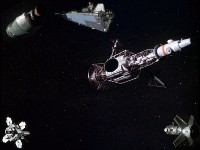
Misc. deep space vehicles. Clockwise from lower left: IAC unmanned B142 probe, "534" type lunar module, NASA "SID-2" lifting body space capsule, IAC Space Tracker, NASA "GSP" manned space probe. |
In practice, NASA, EUROSEC, IAC and SHADO frequently collaborate (e.g. SHADO has no large launch vehicles of its own). The script of the UFO episode "Conflict" establishes that the International Astrophysical Commission became part of a larger "United Space" or "Global Space" in 1980; this may be the same as the "World Space Commission" mentioned in the Space:1999 episode "Dragon's Domain". It is possible that the Moonbase Alpha project was started by this organisation, which presumably became even more important following the 1987 global war which put an end to the east-west conflict. |
|
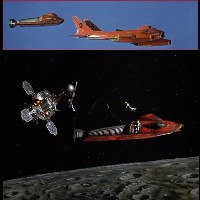
Lunar Module servicing B142 probe in lunar orbit. The vehicle is air-launched from the Lunar Carrier (top) |
The biggest scientific difference vs. Space: 1999 is that superluminal space travel is feasible. The UFOs travel at "SOL" 8 or faster, i.e. eight times the speed of light. They would then be impossible to detect, but SHADO has developed an "Utronic" detector for this purpose. This caused many inconsistencies and practical problems, e.g. in one episode SHADO launches an unmanned B142 tracking probe that somehow manages to keep pace with a UFO returning to its home planet. It was never explained where the UFOs come from. The most logical explanation is the aliens launch their craft from a large mothership (probably a camouflaged asteroid, as shown in the closing credits of the show) stationed at the Sun-Earth L4 or L5 points (the alien base is in the same orbit as Earth, but always 60 degrees away). That would explain why the UFOs always appear from the same direction in space. UFO and Space: 1999 have many similarities, and share many of the same flaws. In both cases the series format is somewhat unwieldy and over dependent on hardware. Many of the story and hardware concepts initially seem "neat!" but turn out to be illogical or underdeveloped upon closer inspection. For instance,Ed Straker's official disguise is supposed to be his "daytime job" as the owner of Harlington-Straker Studios, yet he negotiates directly with other military and commercial space organisations in several episodes. Despite the organisation being secret, the name "SHADO" is written prominently on its ground vehicles and aircraft. |
|

"Skydiver" interior. Many of the submarine's computer panels were later reused in the Dragon's Domain Ultra probe ship. Standing at left is actress Anouska Hempel, who also appeared in The Metamorph. |
The reason for putting SHADO's most important space base on the Moon is never explained (apparently the aliens are stupid enough to only attack when the Moon is between Earth and the UFOs! They should simply wait two weeks...). The "Skydiver" submarine would drive any design engineer to despair as is operates a depth of more than one kilometre while carrying an unprotected hypersonic "Sky" jet fighter capable of Mach 5 flight! Currently, USAF designers struggle with a submarine-launched unmanned aerial vehicle concept that only would have to withstand 60 feet of water pressure... |
|
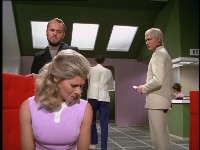
UFO was often edgy and downbeat in its characterisations. Here, Straker confronts his ex-wife Mary after their son's death. Her new husband is played by Philip Madoc, who later would appear in Breakaway. |
The setting is supposedly 1980-1984, although fashion is still in the late 1960s (Nehru jackets are ubiquitous). UFO has dated very badly, in fashion, storylines and Barry Gray's music (although it is still very catchy). Like Space: 1999, the series was widely criticised for wooden characters. The acting is often boring. Unlike 1999, several stories tried to do focus on the affect of the secrecy on relationships, although the results were dull. Many stories rely on reworked spy and soap opera plots. The last episodes in the series were most interesting, as the aliens tried to manipulate minds to attack SHADO. These stories sometimes have a very 1960s focus on hallucinations and trippy weirdness. But at its best the episodes had clever plots and the effects were always impressive. |
|
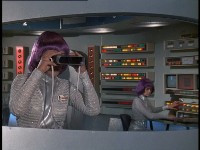
SHADO Moonbase Control Sphere interior. The binoculars would later be used in some Space:1999 episode, including The Last Enemy and The Last Sunset. |
When UFO was shown in the US in September 1972 the ratings were promising. Sylvia Anderson, with new writer Chris Penfold and designer Keith Wilson, began work developing a second series. In the new format, the war with the aliens had escalated and the action had now shifted to space, based in a larger moonbase. The ratings in the US dropped from their initial high (apparently around the end of 1972), and Lew Grade decided not to fund a second series of UFO. The UK trade publication The Stage noted in a letter on 9 November 1972 that UFO was first in its time slot in New York and "a potential dark horse among syndicated series on current release. Gerry Anderson has been asked by ATV to prepare more UFO scripts for, should the series maintain these ratings, it is very possible a new series will be commissioned." Fortunately he would back a new series, reusing some of the concepts from the preproduction work for UFO II. Space: 1999, which was first publicly announced in March 1973. In the initial format for the new series Moon City had been set up to protect against aliens. Moon City's defence included Interceptors and lunar versions of the SHADO mobiles, as well as moon hoppers for lunar excursions. The weaponry was written out by the time the first episode was filmed, but series publicity still explained how Moonbase Alpha was designed to protect the Earth from alien attack. |
|
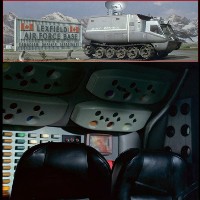
The tank-like SHADO Mobiles had the same interior as the Moonmobiles. The control panel at left would later be reused in the Dragon's Domain Ultra probe set. |
Many people who worked on Space: 1999 had also worked on UFO. Among the familiar names were Gerry and Sylvia Anderson, Reg Hill, Barry Gray and Keith Wilson. SFX director Derek Meddings left Anderson after UFO to work on the James Bond films (he was replaced for Space: 1999 by his deputy Brian Johnson, who worked on Kubrick's 2001 A Space Odyssey while UFO was being filmed). Art director Bob Bell was preparing a third series of Gerry Anderson's The Protectors (the project fell through and he eventually designed The New Avengers). His assistant Keith Wilson stepped up to design Space: 1999 (although the UFO costumes are usually credited to Sylvia Anderson, they were in fact designed by Keith, who also designed the sets). Model designer Mike Trim worked on the nuclear waste areas for Breakaway before returning to teaching. Wag Evans of Space Models, who had built the original Thunderbirds vehicles and many other classic Anderson designs, built the Eagles. Writer Tony Barwick contributed two scripts as a freelance to Space: 1999 Year Two. When director Lee H Katzin dropped out after his second episode of Space: 1999, UFO veteran David Tomblin was brought in on the directing team. |
|

Space:1999 actors in UFO garb: Anouska Hempel and Barry Stokes (top row);Patrick Mower, Shane Rimmer and Mike Stevens (middle row from left to right); Douglas Wilmer (bottom left). |
None of the principal UFO actors appeared in Space:1999 and vice versa. However, several members of the supporting cast can be seen in both series including: Patrick Allen, John Clifford, Stuart Damon, Anouska Hempel, Drewe Henley, Susan Jameson, Philip Madoc, Patrick Mower, Shane Rimmer, Bob Sherman, Mike Stevens, Barry Stokes, Maureen Tan and Douglas Wilmer.
|
|
Images copyright Granada Ventures
Page copyright Martin Willey